
Jug, probably Morgan, Van Wickle, and Green pottery, Old Bridge, New Jersey, ca. 1805–1822. Salt-glazed stoneware. H. 12". (Private collection; all photos by Gavin Ashworth unless otherwise noted.) Incised jug, highlighted with cobalt decoration depicting a devil. From the devil’s mouth is a balloon in which is inscribed “Money.”

Side view of the jug illustrated in fig. 1.
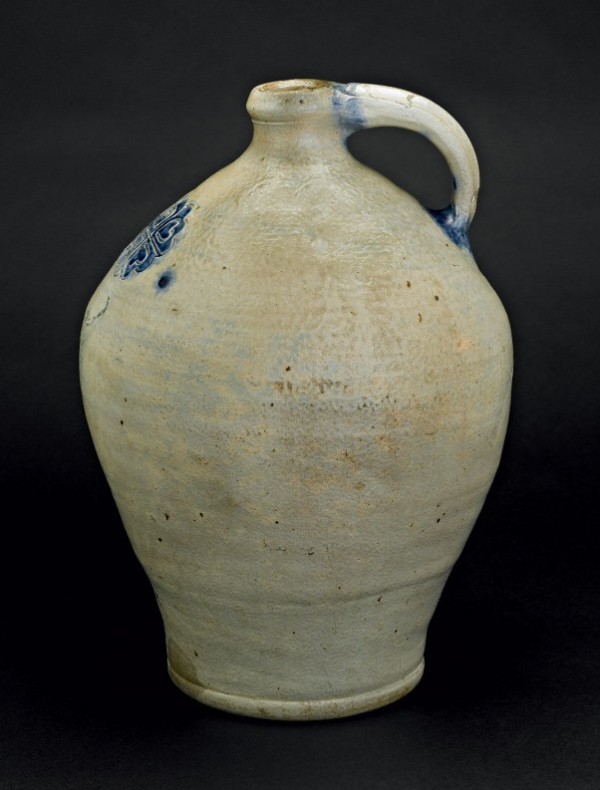
Jug, Morgan, Van Wickle, and Green pottery, Old Bridge, New Jersey, ca. 1805–1822. Salt-glazed stoneware. H. 12". (Private collection.)
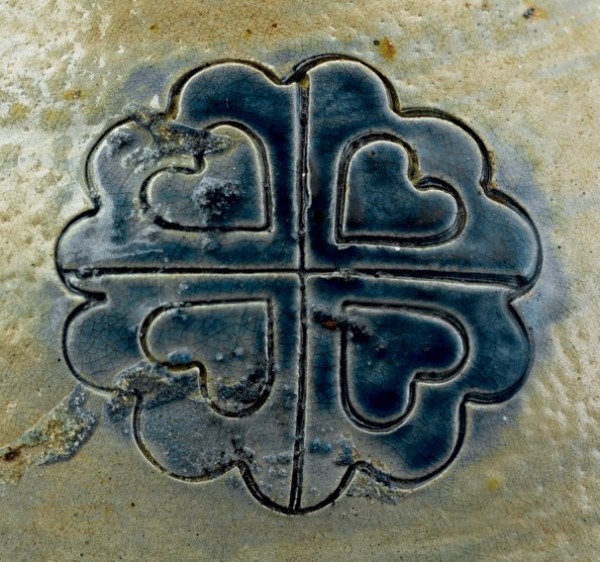
Detail of the stamped four-hearts motif on the jug illustrated in fig. 3.

Sherd, Morgan, Van Wickle, and Green pottery, Old Bridge, New Jersey, ca. 1805–1822. Salt-glazed stoneware. (Courtesy, Robert Sim Collection, Monmouth County Historical Association.)
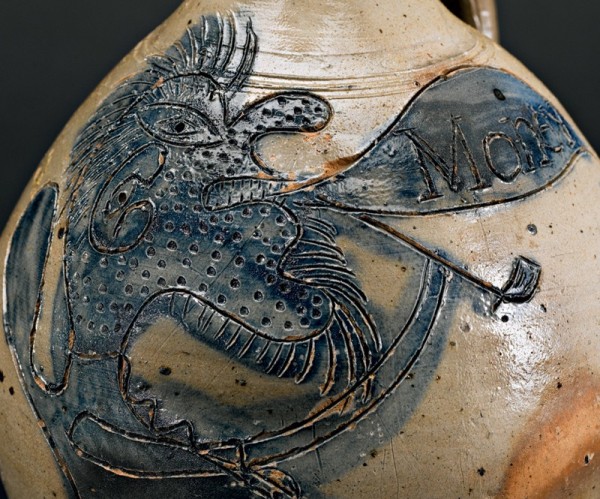
Detail of the devil’s head and the inscription on the jug illustrated in fig. 1.
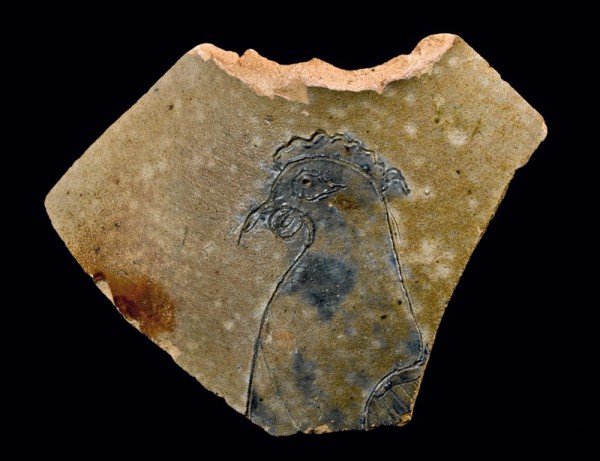
Sherd, Morgan, Van Wickle, and Green pottery, Old Bridge, New Jersey, ca. 1805–1822. Salt-glazed stoneware. (Courtesy, Robert Sim Collection, Monmouth County Historical Association.)

Jug, attributed to the Morgan, Van Wickle, and Green pottery, Old Bridge, New Jersey, ca. 1805–1822. Salt-glazed stoneware. H. 11 1/8". (Courtesy, Philadelphia Museum of Art; photo courtesy Philadelphia Museum of Art.)
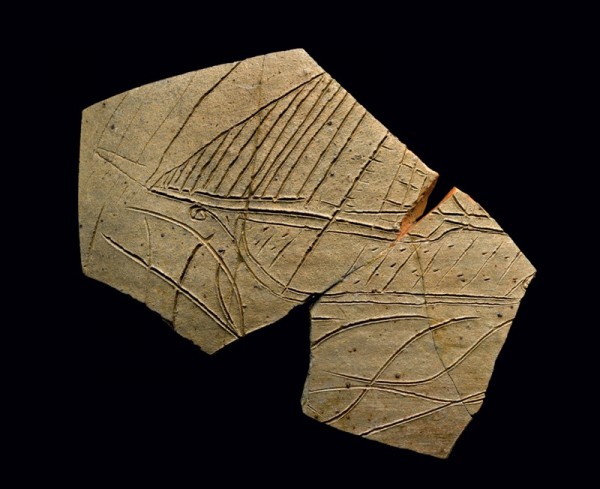
Sherd, Morgan, Van Wickle, and Green pottery, Old Bridge, New Jersey, ca. 1805–1822. Salt-glazed stoneware. (Courtesy, Robert Sim Collection, Monmouth County Historical Association.)
Illustrated in figures 1 and 2 is an exceptional incised and decorated salt-glazed stoneware jug bearing the image of a devil.[1] Although washed in a rich cobalt blue, this devil is the stuff of nightmares. His pockmarked face plays up a large nose, bewhiskered protruding chin, and sharp, pointed teeth. He has an enormous potbelly, a thin ratlike tail, and cloven feet. He smokes from a long clay pipe as he prances and chants “Money.” The jug is illustrated in Georgeanna Greer’s American Stonewares (1981), which attributes its probable origin to New York State.[2] For several reasons, however, we believe that the jug was made at the Morgan, Van Wickle, and Green pottery of Old Bridge, New Jersey, which was active from 1805 to 1822.
First, consider the resemblance between the devil jug illustrated in figure 1 and a jug we know to be from the Morgan, Van Wickle, and Green pottery (figs. 3, 4). The latter vessel has the stamped four-hearts motif found by Robert J. Sim on sherds from the Old Bridge pottery site that are currently in the Sim Collection at the Monmouth County Historical Association (MCHA), Freehold, New Jersey. Both jugs display tall ovoid profiles with necks that are smooth, without tooling. Both jugs have pulled handles, each with a cobalt ring encircling its terminals, that begin at the upper lip and are cut off and attached directly to the shoulders, then smoothed into the body. Both jugs also have simple tooled heels and salt-glazed, plain-cut bases smoothed by a sponge.
Second, the kiln furniture marks on the bottom of the devil jug match those on the known Morgan, Van Wickle, and Green pottery jug: a rectangular mark on the base measuring exactly the same, 1 1/2 by 3 inches. The devil jug also has three 2-inch, crescent-shaped marks on its shoulders and side. The same kiln furniture marks have been seen on various other Morgan, Van Wickle, and Green jugs and jars, in the mcha as well as in private collections.
Third, the devil jug and sherds found on site by Sim at the Old Bridge pottery share several decorative details. For example, one sherd shows a caricature of a large-nosed, bald man who smokes a pipe similar to the one being smoked by the devil (fig. 5). This sherd also displays punch marks—marks made with a rodlike implement—that match those used extensively on the devil jug.
Although triangular punch marks outline the edges of the bald man’s jacket, more telling is the single round mark measuring 1/16 inch in diameter that delineates the pupil of his eye—as it does that of the devil. This same mark also forms the devil’s ear canal, the pock marks on his face, and the buttons on the front of his jacket (fig. 6). Though smaller in diameter, the same circular impression forms the pupil on the eye of a chicken decorating yet another MCHA sherd from the Morgan, Van Wickle, and Green pottery (fig. 7). As well, a jug in the collections of the Philadelphia Museum of Art displays two incised ship designs, one of which uses numerous deep punch marks to characterize its mainsail and to represent the stars on its American flag (fig. 8). It, too, can be attributed to the Morgan, Van Wickle, and Green pottery on the basis of a sherd in the Sim Collection at the MCHA showing a similar image in the same hand (fig. 9), again reinforcing the unique use of punching at the pottery.
The image on the devil jug might represent an early manifestation of the “New Jersey Devil” legend in Atlantic County, then part of Burlington County, as it incorporates features from several versions of the legend. All of the versions begin about 1735 with a Mrs. Leeds or a Mrs. Shourds of Leeds Point, mother of twelve, who was pregnant with an unwanted, thirteenth child. Before she gave birth, she declared, “I hope it’s a devil”—and got her wish. Some say the child was born a normal baby but soon changed into a creature with cloven hooves, a horse’s head, and a forked tail, with bat wings that lifted him up and out the chimney. Another version says the baby was born deformed, and when he flapped his arms one stormy night they changed into wings and he flew away.[3]
From horned head and rat tail to cloven hooves and equine countenance, the devil jug displays many of the traits described in the legends. Of particular interest, however, is his left arm, which has a paddle-shaped appendage. Since the legend emphasizes the child changing into a devil, we hypothesize that the stoneware decorator chose to illustrate the process of transformation.
We also suggest that the word “Money” conveys the message that focusing on material gain can turn a human into a devil. Perhaps it is also an admonition to remember 1 Timothy 6:10 in the King James Version of the New Testament, which warns that “the love of money is the root of all evil.”
Whatever the case, the coupling of the jug’s decoration with regional legend provides strong evidence that this figure does indeed represent the New Jersey Devil. The Old Bridge pottery and the devil get their due.
Peter Warwick and Leslie Warwick; landpwarwick@aol.com
Formerly in the collections of Barry Cohen, New York, and Jerome Banta.
Georgeanna H. Greer, American Stonewares: The Art and Craft of Utilitarian Potters (Exton, Pa.: Schiffer, 1981), p. 237.
Henry Charlton Beck, Jersey Genesis: The Story of the Mullica River (New Brunswick, N.J.: Rutgers University Press, 1963), pp. 243–45.
